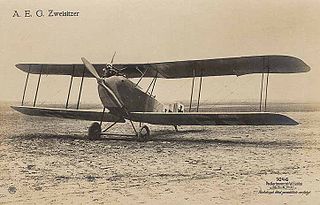
The AEG C.IV was a two-seat biplane reconnaissance aircraft designed and produced by the German aircraft manufacturer Allgemeine Elektrizitäts-Gesellschaft.

The AEG J.I was a German biplane ground attack aircraft designed and produced by the German aircraft manufacturer Allgemeine Elektricitäts-Gesellschaft. It was a mission-specific derivative of the AEG C.IV reconnaissance aircraft.

The Albatros C.III was a twin-seat general-purpose biplane designed and produced by the German aircraft manufacturer Albatros Flugzeugwerke. It was produced in greater numbers than any other C-type aircraft by Albatros as well as being the company's most-produced twin-seat aircraft.

The Albatros C.I,, was a twin-seat general-purpose biplanes designed and produced by the German aircraft manufacturer Albatros Flugzeugwerke. It was the first of the successful C-series aircraft operated by the Luftstreitkräfte.

The Albatros B.II, was an unarmed two-seat reconnaissance biplane designed and produced by the German aircraft manufacturer Albatros Flugzeugwerke. It was the aircraft that brought Albatros Flugzeugwerke to the world's attention.
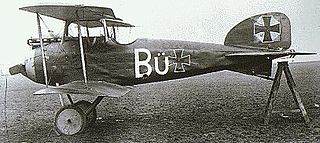
The Albatros D.I was an early fighter aircraft designed and produced by the German aircraft manufacturer Albatros Flugzeugwerke. It was the first of the Albatros D types which equipped the majority of the German and Austrian fighter squadrons (Jagdstaffeln) for the last two years of the First World War. Despite this, the D.I had a relatively brief operational career, having been rapidly eclipsed by rapid advances in fighter aircraft.

The Pfalz D.III was a fighter aircraft used by the Luftstreitkräfte during the First World War. The D.III was the first major original design from Pfalz Flugzeugwerke. Though generally considered inferior to contemporary Albatros and Fokker fighters, the D.III was widely used by the Jagdstaffeln from late 1917 to mid-1918. It continued to serve as a training aircraft until the end of the war.
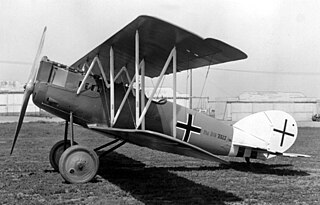
The Pfalz D.XII is a German fighter aircraft built by Pfalz Flugzeugwerke. Designed by Rudolph Gehringer as a successor to the Pfalz D.III, the D.XII entered service in significant numbers near the end of the First World War. It was the last Pfalz aircraft to see widespread service. Though the D.XII was an effective fighter aircraft, it was overshadowed by the highly successful Fokker D.VII.

The Albatros W.4 was a military floatplane designed and produced by the German aircraft manufacturer Albatros Flugzeugwerke.
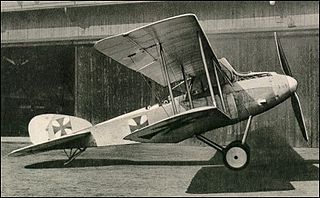
The Albatros C.V was a military reconnaissance aircraft designed and produced by the German aircraft manufacturer Albatros Flugzeugwerke.

The Albatros C.VII was a military reconnaissance aircraft designed and produced by the German aircraft manufacturer Albatros Flugzeugwerke. It was a revised and re-engined development of the Albatros C.V, which had proved disappointing in service.

The Albatros C.X was a military reconnaissance aircraft designed and produced by the German aircraft manufacturer Albatros Flugzeugwerke.

The Albatros C.XII was a military reconnaissance aircraft designed and produced by the German aircraft manufacturer Albatros Flugzeugwerke.

The Albatros C.XV was a German military reconnaissance aircraft developed during World War I. It was essentially a refinement of the C.XII, which had been put into production in 1918. The war ended before any examples became operational. However, some found their way into civilian hands and flew as transport aircraft in peacetime under the factory designation L 47. Others saw service with the air forces of Russia, Turkey, and Latvia.

The Halberstadt C.V was a German single-engined reconnaissance biplane of World War I, built by Halberstädter Flugzeugwerke. Derived from the Halberstadt C.III, with a more powerful supercharged 160 kW (220 hp) Benz Bz.IVü engine, it saw service only in the final months of the war. Cameras were mounted in the observer's cockpit floor.

The Halberstadt CL.IV is a German ground attack aircraft of World War I.

The Junkers J.I was a German "J-class" armored sesquiplane of World War I, developed for low-level ground attack, observation and army cooperation. It is especially noteworthy as being the first all-metal aircraft to enter mass production; the aircraft's metal construction and heavy armour was an effective shield against small arms fire over the battlefield.
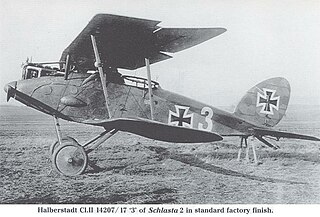
The Halberstadt CL.II was a German two-seat escort fighter/ground attack aircraft of World War I. It served in large numbers with the German Luftstreitkräfte in 1917-18.
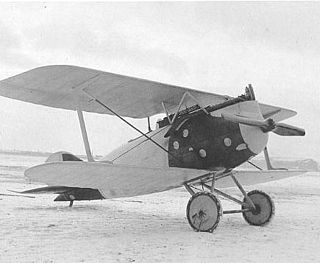
The Rumpler D.I was a fighter-reconnaissance aircraft produced in Germany at the end of World War I. It was a conventional single-bay biplane with wings of unequal span braced by I-struts. It featured an open cockpit and a fixed, tailskid undercarriage. The upper wing was fitted with aerodynamically balanced ailerons and fuselage had an oval cross-section.
The Rumpler C.IX was a German single-engine, two-seat reconnaissance biplane of World War I.






















